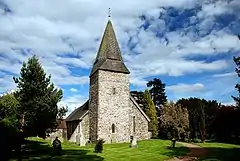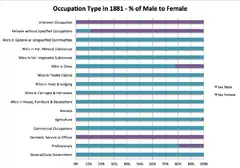| Ditton Priors | |
|---|---|
 St. John the Baptist Church | |
 Ditton Priors Location within Shropshire | |
| Population | 821 (2011)[1] |
| OS grid reference | SO607892 |
| Civil parish |
|
| Unitary authority | |
| Ceremonial county | |
| Region | |
| Country | England |
| Sovereign state | United Kingdom |
| Post town | BRIDGNORTH |
| Postcode district | WV16 |
| Dialling code | 01746 |
| Police | West Mercia |
| Fire | Shropshire |
| Ambulance | West Midlands |
| UK Parliament | |
Ditton Priors is a village and civil parish in south Shropshire, England. Historically, it was also known as Priors Ditton.
The nearest town is Bridgnorth. The village is situated near to Shropshire's highest hill, Brown Clee Hill.
The Church of St. John the Baptist
St. John the Baptist is the church located in Ditton Priors and was dedicated to Saint Mary The Virgin in the 15th century.[2] Parts of the church are thought to date back to the 12th century.[3] The church is located in the centre of the village, on higher ground than its surroundings. The majority of the church is built from Dhustone, from the nearby Clee Hill. The interior of the church houses stained glass and an open timber roof. The churchyard contains a war grave of a King's Shropshire Light Infantry soldier of World War I[4] and the clock on the south wall of the tower was given as a memorial to parish men who died in the same war.[5]
The Howard Arms

The building that is now The Howard Arms dates back to the 18th century, where it was used as a vicarage and a public house. It is one of the larger 18th century establishments in the village.[3] It now serves as a local pub.
Cleobury Mortimer and Ditton Priors Light Railway
The Cleobury Mortimer and Ditton Priors Light Railway once ran to the village and during (and for a period after) the Second World War there was a major military armaments depot near the village because of the village's remote, rural location and the railway link.
The light railway was built 1907–1908, with its purpose being to carry stone from Abdon Burf quarry. It was under operation of the Great Western Railway, and ran from Ditton Priors to Cleobury Mortimer. From there, it joined the line from Bewdley to Tenbury Wells. A passenger service operated for thirty years between 1908 and 1938. The line served the Royal Naval Armaments Depot, which was located near the village and was in operation between 1939 and 1965.[6]
Archaeological finds
There have been archaeological finds in close proximity to Ditton Priors. A basalt axe hammer and flints have been located at Lightwood and Oakwood. Abdon Burf hill fort lies within the parish. It was one of the most impressive Iron Age forts in Shropshire until it was largely destroyed by mining and quarrying.[6]
Census data
The Census is a country wide survey that allows the government to see and control where funding is needed most. The data is available for public use and distribution and is carried out every 10 years.[7]
In 1831, the structure of social class was very different. A high percentage of the population were labourers/servants, and middling sorts, while a very low percentage of the population were employers or professionals.[8]
By looking at historical occupation data, males dominate the majority of the occupation types in comparison to females, which is not uncommon for the period of time that the census data was taken. A large percentage of females, however, worked in domestic offices and services, but a very small proportion worked in agriculture or as a professional.

| Year | Pop. | ±% |
|---|---|---|
| 1801 | 620 | — |
| 1811 | 649 | +4.7% |
| 1821 | 685 | +5.5% |
| 1831 | 584 | −14.7% |
| 1841 | 660 | +13.0% |
| 1851 | 583 | −11.7% |
| 1861 | 598 | +2.6% |
| 1871 | 581 | −2.8% |
| 1881 | 501 | −13.8% |
| 1891 | 619 | +23.6% |
| 1901 | 650 | +5.0% |
| 1911 | 613 | −5.7% |
| 1921 | 701 | +14.4% |
| 1931 | 617 | −12.0% |
Neighbourhood statistics
When looking at neighbourhood statistics, the settlement of Ditton Priors falls into the neighbourhood of Bridgnorth (007A). When looking at a summary of deprivation in the area, Ditton Priors and its surrounding area suffers from an above average level of deprivation.[10] The neighbourhood contains approximately 1588 residents with 687 dwellings. Because Ditton Priors is a rural settlement, it faces an element of socio-economic deprivation because of its location and proximity to services, such as health care and educational establishments.
Educational Establishments
Brown Clee CE Primary School
Set in the countryside of Shropshire, the primary school in Ditton Priors serves the village itself, along with the surrounding settlements. The school was built in 1994[11] and provides students with a "good" standard of teaching, as surveyed by Ofsted in 2014.[12]
Secondary schools
There are no secondary schools in Ditton Priors. The nearest secondary schools are located in Bridgnorth.[13]
Further Education
The nearest college for students aged 16 or higher is in Ludlow.[14]

Transport
The village lies approximately 147 miles from London.
The nearest rail station is approximately 9.9 miles away.
The nearest airport is Birmingham Airport, which is approximately 35.8 miles away.[15]
Climate
Ditton Priors, located within the region of The Midlands, is at the geographical heart of England, giving it a mixture of climatical characteristics. It acts as a transitional area between the northern and southern parts of England when regarding temperature, and between Wales and the East of England when regarding rainfall.[16]
As with much of the United Kingdom, the coldest month is January, while the warmest month is July. Altitude affects average temperature results, with the Severn Valley to the south and the Peak District to the north of The Midlands contributing to the average climate figures for the region.
| Climate data for The Midlands | |||||||||||||
|---|---|---|---|---|---|---|---|---|---|---|---|---|---|
| Month | Jan | Feb | Mar | Apr | May | Jun | Jul | Aug | Sep | Oct | Nov | Dec | Year |
| Mean daily maximum °C (°F) | 6.3 (43.3) |
6.7 (44.1) |
9.3 (48.7) |
11.7 (53.1) |
15.5 (59.9) |
18.2 (64.8) |
20.9 (69.6) |
20.5 (68.9) |
17.4 (63.3) |
13.3 (55.9) |
9.3 (48.7) |
7.2 (45.0) |
13.1 (55.6) |
| Mean daily minimum °C (°F) | 0.8 (33.4) |
0.7 (33.3) |
2.2 (36.0) |
3.4 (38.1) |
6.1 (43.0) |
9.0 (48.2) |
11.2 (52.2) |
11.0 (51.8) |
9.0 (48.2) |
6.2 (43.2) |
3.2 (37.8) |
1.7 (35.1) |
5.4 (41.7) |
| Average precipitation mm (inches) | 76.0 (2.99) |
55.5 (2.19) |
62.0 (2.44) |
57.1 (2.25) |
55.7 (2.19) |
63.0 (2.48) |
51.8 (2.04) |
65.2 (2.57) |
69.2 (2.72) |
74.1 (2.92) |
73.2 (2.88) |
82.7 (3.26) |
785.5 (30.93) |
| Source: Met Office[17] | |||||||||||||
Notable people
Fred Jordan (1922-2002), folk singer, died in a residential home at Ditton Priors.
See also
References
- ↑ "Civil Parish population 2011". Retrieved 25 November 2015.
- ↑ "St. John The Baptist, Ditton Priors". Shropshire Tourism. Archived from the original on 16 July 2012. Retrieved 2012-05-01.
- 1 2 "Ditton Priors". British History Online.
- ↑ "Lance Corporal F J SHINGLER". CWGC Casualty Record. Retrieved 26 October 2022.
- ↑ Francis, Peter (2013). Shropshire War Memorials, Sites of Remembrance. YouCaxton Publications. p. 110. ISBN 978-1-909644-11-3.
- 1 2 "Ditton Priors". British History Online.
- ↑ "2011 Census - Office for National Statistics".
- ↑ "Ditton Priors CP/AP through time | Social Structure Statistics | Social Status, based on 1831 occupational statistics". Visionofbritain.org.uk. Retrieved 7 March 2022.
- ↑ "Ditton Priors CP/AP through time | Industry Statistics | Occupation data classified into the 24 1881 'Orders', plus sex". Visionofbritain.org.uk. Retrieved 7 March 2022.
- ↑ "Check Browser Settings". Archived from the original on 3 March 2016. Retrieved 19 April 2012.
- ↑ "Brown Clee CE Primary School". brownclee.shropshire.sch.uk. Archived from the original on 30 September 2012. Retrieved 2012-04-19.
- ↑ "Find an inspection report and registered childcare". Ofsted. 8 October 2020.
- ↑ "Schools within 15 miles of WV16 6SS". Schools-search.co.uk. Retrieved 7 March 2022.
- ↑ "Schools within 15 miles of WV16 6SS". Schools-search.co.uk. Retrieved 7 March 2022.
- ↑ "Transport Direct". Archived from the original on 18 February 2013. Retrieved 23 March 2012.
- ↑ "Met Office: Regional Climate: Midlands". Archived from the original on 26 September 2011. Retrieved 19 April 2012.
- ↑ "Met Office: Climate averages 1971–2000". Archived from the original on 6 April 2012. Retrieved 18 April 2012.